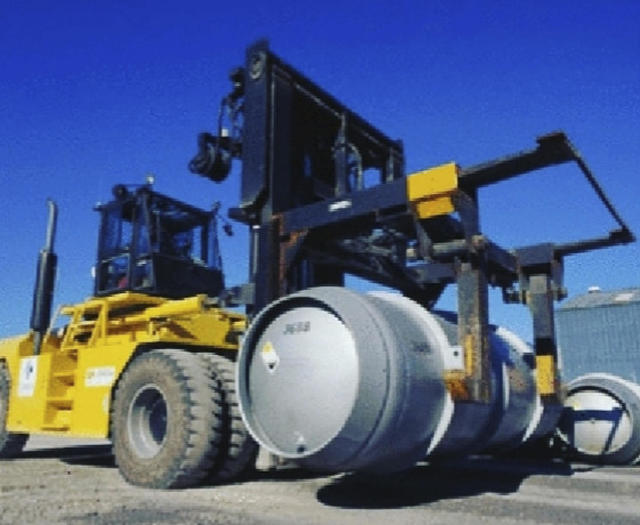Tehran — Iran has begun producing uranium enriched to 60 percent at its Fordo plant, official media reported Tuesday about the underground facility that reopened three years ago amid the breakdown of its nuclear deal with major powers. The move was part of Iran‘s response to the United Nations nuclear watchdog’s adoption last week of a censure motion drafted by Western governments accusing it of non-cooperation.
“Iran has started producing uranium enriched to 60 percent at the Fordo plant for the first time,” Iran’s ISNA news agency reported.
While 60 percent enriched uranium still isn’t technically weapons-grade (weapons require uranium enriched to 90 percent or higher), having a significant stockpile of it could reduce the time Iran would need to make a bomb.
Iran has always denied any ambition to develop a nuclear weapon, insisting its nuclear activities are for civilian purposes only, but the U.S. and its allies — most notably Israel and major European powers — don’t trust Tehran.
Under the landmark 2015 nuclear deal, Iran agreed to mothball the Fordo plant and limit its enrichment of uranium at other facilities to 3.67 percent, which is sufficient for most civilian uses, as part of a package of restrictions on its nuclear activities aimed at preventing it covertly developing a nuclear weapon. In return, major powers including the U.S. agreed to relax sanctions they had imposed over Iran’s nuclear program.
But the deal began falling apart in 2018 when then U.S. President Donald Trump pulled Washington out of the agreement and reimposed crippling economic sanctions on Iran unilaterally.
The following year, Iran began stepping away from its commitments under the deal. It reopened the Fordo plant and starting enriching uranium to higher levels.
In January 2021, Iran said it was working to enrich uranium to 20 percent at Fordo. Several months later another Iranian enrichment plant, Natanz, reached 60 percent.
France, Germany and the U.K., which were all party to the now-defunct 2015 nuclear agreement, expressed “grave concern” last year over Iran’s upgrade to 60 percent and said the Islamic Republic had “no credible civilian need for enrichment at this level.”
President Joe Biden has expressed a desire for Washington to return to a revived version of the agreement and on-off talks have been underway since April last year, but Secretary of State Antony Blinken said late last month that he saw little scope to restore the deal, as Iran battles nationwide protests sparked by the September death in police custody of Mahsa Amini, a 22-year-old Kurdish woman.
Commenting Tuesday on the Iranian announcement, U.S. special envoy for Iran Robert Malley said Washington had seen Tehran’s response to the International Atomic Energy Agency (IAEA) censure motion coming.
“Unfortunately, the Iranian response was not unexpected,” Malley told the Al Jazeera television network, adding that the U.S. would closely monitor the next steps taken by Iran.
Asked about negotiations to revive the nuclear deal, Malley said Tehran’s crackdown on anti-government protests, and the Islamic Republic’s admitted sale of drones to Russia for its war in Ukraine, had turned the Washington’s focus away from the discussions.
Implementation of the 2015 deal was overseen by the IAEA, but the U.N. watchdog’s relations with Iran have declined sharply in recent months. The IAEA board of governors passed a resolution on Thursday criticizing Iran for its lack of cooperation.
Iran announced late Sunday that it had begun taking retaliatory measures but did not specify what they were.
“In response to the recent action of three European countries and the United States in the adoption of a resolution against Iran, some initial measures have been decided by the Atomic Energy Organization of Iran,” foreign ministry spokesman Nasser Kanani said.
The ISNA news agency said the upgraded enrichment at Fordo was one part of Iran’s response.

Nov. 1, 2019 satellite image provided by provided by Maxar Technologies shows the Fordo nuclear facility, just north of the holy city of Qom in Iran
“As well, in a second action in response to the resolution, Iran injected (uranium hexafluoride) gas into two IR-2m and IR-4 cascades at the Natanz plant,” it said, referring to an older enrichment facility where uranium was already being enriched to 60 percent.
The U.N. watchdog has been pressing Iran to explain the discovery of traces of nuclear material at three sites it had not declared, a key sticking point that led to the adoption of an earlier censure motion by the IAEA in June.
In a report seen by AFP earlier this month, the IAEA said Iran’s stockpile of enriched uranium stood at 3,673.7 kilograms as of October 22, a decrease of 267.2 kilograms from the last quarterly report. But that included significant stockpiles of uranium enriched to higher levels — 386.4 kilograms to 20 percent and 62.3 kilograms to 60 percent.
The IAEA complains that the ability of its inspectors to monitor Iran’s stepped-up nuclear activities has been hampered by restrictions imposed by Iran.









